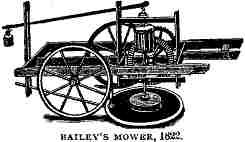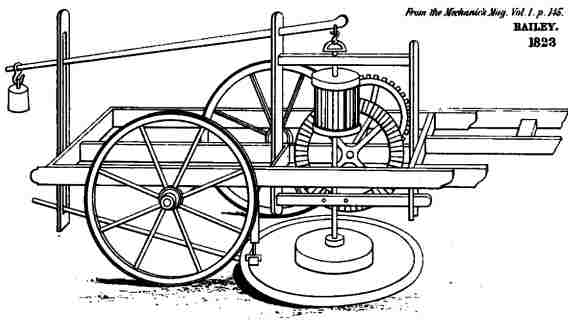Jeremiah
Bailey, of Chester county, Pa., Feb. 13, 1822, patented a
mower or grass-cutting machine which made considerable stir at the
time, in England as well as in this country. The Mechanic's Magazine
(British) [at page 145, of vol i]*, 1823, describes it as follows:
[p.83]

......
[p.86]
From: "Mowers," American Agricultural Implements, by Robert L. Audrey, c.1894], pages 45, 78-79, 83, 86.
(source)
* Additional quotes from the Mechanic's Magazine inserted from Appendix to the specifications of English patents for reaping machines. (Comm. of patents), by Bennet Woodcroft, page 36, and illustration from Plate XIV shown below.
(source) as digitized by Google
See also:
"The mowing machine of which
the above cut is a representation was invented by Jeremiah Bailey, of Chester
county, United States, who has obtained a patent for the same.
It has been extensively used and approved of during the last season in the neighborhood of the patentee, and promises to be of great public utility. It is understood that it will mow ten acres per day. The following description will explain its operation and show the skill and ingenuity of the inventor:
"This machine is supported by two wheels on different axles. The left wheel is fixed to its axle, so that they revolve together. The right revolves on its axle like a common cart wheel, and is placed about a foot further back than the other. The left works within the frame, and has a circle of cogs screwed on the outside of the felloes, but of a less diameter, to keep them from the ground. These cogs work into a vertical cog wheel in front that turns an iron shaft extending horizontally toward the center of the machine; upon the inner end of this shaft is fixed a vertical face wheel, whose cogs turn a trundle-head on a vertical shaft. To the bottom of this shaft, near the ground, is fixed a circular horizontal framework, on the circumference of which is screwed the scythes in six parts, laid horizontally, with the edges turned outward, so as to form a complete circle. To keep the scythes at a proper distance from the ground the bottom of the shaft is supported on a piece of wood of the machine, secured by a tye from the tail, somewhat resembling a sled runner, in which it works in the manner of a gudgeon; with the inequalities of the ground the scythe frame shaft and trundle-head rise and fall.
The edge of the scythe, in its revolution, passes under a whetstone fixed on an axis, and revolving with the scythe. To create friction this axis is more or less inclined to the line of the direction of the revolution, according to the friction required. This stone, by means of a sliding rod by which it is attached to the machine, rises and falls with the scythes.
[To prevent too great a pressure of the trundle shaft and scythe frames on the ground, a lever, like a steel-yard, is fixed to the top of the shaft, extending into the tail of the machine, where it is weighed according to the nature of the ground or grass.]*
The horse is put into shafts and walks in front of the left side of the machine, and always on the mowed ground after the first swath is cut.
[By the increase of velocity the scythes revolve with great swiftness.]* The grass as it is cut is first thrown by the progressive motion against a rise in the scythe frame toward the center, and by the same motion is afterward thrown off in a regular row, following the center of the machine." ...
......It has been extensively used and approved of during the last season in the neighborhood of the patentee, and promises to be of great public utility. It is understood that it will mow ten acres per day. The following description will explain its operation and show the skill and ingenuity of the inventor:
"This machine is supported by two wheels on different axles. The left wheel is fixed to its axle, so that they revolve together. The right revolves on its axle like a common cart wheel, and is placed about a foot further back than the other. The left works within the frame, and has a circle of cogs screwed on the outside of the felloes, but of a less diameter, to keep them from the ground. These cogs work into a vertical cog wheel in front that turns an iron shaft extending horizontally toward the center of the machine; upon the inner end of this shaft is fixed a vertical face wheel, whose cogs turn a trundle-head on a vertical shaft. To the bottom of this shaft, near the ground, is fixed a circular horizontal framework, on the circumference of which is screwed the scythes in six parts, laid horizontally, with the edges turned outward, so as to form a complete circle. To keep the scythes at a proper distance from the ground the bottom of the shaft is supported on a piece of wood of the machine, secured by a tye from the tail, somewhat resembling a sled runner, in which it works in the manner of a gudgeon; with the inequalities of the ground the scythe frame shaft and trundle-head rise and fall.
The edge of the scythe, in its revolution, passes under a whetstone fixed on an axis, and revolving with the scythe. To create friction this axis is more or less inclined to the line of the direction of the revolution, according to the friction required. This stone, by means of a sliding rod by which it is attached to the machine, rises and falls with the scythes.
[To prevent too great a pressure of the trundle shaft and scythe frames on the ground, a lever, like a steel-yard, is fixed to the top of the shaft, extending into the tail of the machine, where it is weighed according to the nature of the ground or grass.]*
The horse is put into shafts and walks in front of the left side of the machine, and always on the mowed ground after the first swath is cut.
[By the increase of velocity the scythes revolve with great swiftness.]* The grass as it is cut is first thrown by the progressive motion against a rise in the scythe frame toward the center, and by the same motion is afterward thrown off in a regular row, following the center of the machine." ...
[p.83]

[p.86]
... TWO-WHEELED MOWERS WITH
HINGED BARS.
Apparently the first conception of flexibility or automatic
adjustability to the ground surface in the cutting apparatus was shown
in the mower of Jeremiah Bailey, 1822. ...From: "Mowers," American Agricultural Implements, by Robert L. Audrey, c.1894], pages 45, 78-79, 83, 86.
(source)
* Additional quotes from the Mechanic's Magazine inserted from Appendix to the specifications of English patents for reaping machines. (Comm. of patents), by Bennet Woodcroft, page 36, and illustration from Plate XIV shown below.
(source) as digitized by Google
See also:
- Today in Science History event description for issue of patent to Peter Gaillard on 4 Dec 1812.
- Today in Science History event description for issue of patent to Jeremiah Bailey on 13 Feb 1822.

